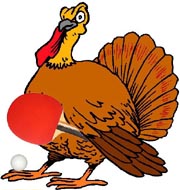JOOLA North American Teams
I'm at the Teams in Baltimore, so this will be a shorter entry. I'm only coaching, but it's going to be a busy tournament since I'm coaching multiple players. I'm just thankful I don't have to play on the cement floors, which leave my knees in the same state of your average turkey in Thanksgiving. Come to think of it, I'm going to be in a hall with over 800 people walking about with blades, all looking for chances to kill.
Catch-up time
With about 10% of the USATT membership at the North American Teams, here's the chance for the other 90% to gain on them! What part of your game needs work? What part of your game can you turn into an overpowering strength? Go practice these aspects. Above all, practice your serves - more than anything else, that's the aspect of your game you can control. You might never develop great footwork or strokes, but you can always develop great serves. Here's an article on "How to Move Up a Level" - this is your chance to really work on moving beyond your current peers. Develop that overpowering strength that will strike fear in the hearts of all who oppose you. Here's an article on developing an overpowering strength. And since we're on the subject of improving, here are 14 articles on how to improve (including the two just mentioned):
How to Improve


 Photo by Donna Sakai
Photo by Donna Sakai





